Ergonomics Design and Assistance Strategy of A-Suit
Abstract
:1. Introduction
2. Materials and Methods
2.1. Ergonomics Design of A-Suit
2.1.1. Optimization of Anchor Locations
2.1.2. Ergonomics Design of the A-Suit System
2.2. Assistance Strategy of A-Suit
2.2.1. Profile of the Auxiliary Force
2.2.2. Initial Displacement of the Bowden Cable
2.2.3. Adaptive Detection Algorithm
2.3. Control Strategy of the A-Suit
3. Results
4. Discussion
5. Conclusions
Author Contributions
Funding
Institutional Review Board Statement
Conflicts of Interest
Appendix A

| Params | Values | Params | Values |
|---|---|---|---|
| Og/mm | (247.61, 255.83) | rg/mm | 310.63 |
| Oh/mm | (−82.75, −32.82) | rh/mm | 80.52 |
| φh/° | 150~198 | φg/° | 100~194 |
| Params | Values | Params | Values |
|---|---|---|---|
| φa0/° | 189 | φh0/° | 126 |
| φg0/° | 59 | A/mm | (−59.6, 207.2) |
| B/mm | (−129.4, 32.7) | dmax/mm | 143.73 |
References
- Yang, B.; Huang, J.; Chen, X.; Xiong, C.; Hasegawa, Y. Supernumerary Robotic Limbs: A Review and Future Outlook. IEEE Trans. Med. Robot. Bionics 2021, 3, 623–639. [Google Scholar] [CrossRef]
- Zoss, A.B.; Kazerooni, H.; Chu, A. Biomechanical Design of the Berkeley Lower Extremity Exoskeleton. IEEE-ASME Trans. Mechatron. 2006, 11, 128–138. [Google Scholar] [CrossRef]
- Yoko, I.; Michiko, I. Global Rulemaking Strategy for Implementing Emerging Innovation. Case of Medical/Healthcare Robot, HAL by Cyberdyne. Policy Discuss. Pap. Jpn. (In Japanese). 2019, 1–27. [Google Scholar]
- Stearns-Yoder, K.A.; Brenner, L.A. Novel Psychological Outcomes with Ekso Bionics Technology. Arch. Phys. Med. Rehabil. 2018, 99, 70–71. [Google Scholar] [CrossRef]
- Zeilig, G.; Weingarden, H.; Zwecker, M.; Dudkiewicz, I.; Esquenazi, A. Safety and Tolerance of the ReWalk Exoskeleton Suit for Ambulation by People with Complete Spinal Cord Injury: A Pilot Study. J. Am. Paraplegia Soc. 2012, 35, 96–101. [Google Scholar] [CrossRef] [Green Version]
- Xiloyannis, M.; Alicea, R.; Anna-Maria, G.; Haufe, F.L.; Riener, R. Soft Robotic Suits: State of the Art, Core Technologies, and Open Challenges. IEEE Trans. Robot. 2021, 38, 1343–1362. [Google Scholar] [CrossRef]
- Natalia, S.; Simha, S.N.; Donelan, J.M.; Finley, J.M. Taking Advantage of External Mechanical Work to Reduce Metabolic Cost: The Mechanics and Energetics of Split-belt Treadmill Walking. J. Physiol. 2020, 98, 324–339. [Google Scholar]
- Kim, J.; Lee, G.; Heimgratne, R.; Revi, D.A.; Karavas, N.; Nathanson, D.; Galiana, L.; Eckert-Erdheim, A.; Murphy, P.; Perry, D.; et al. Reducing the Metabolic Rate of Walking and Running with a Versatile, Portable Exosuit. Science 2019, 365, 668–672. [Google Scholar] [CrossRef]
- Haufe, F.L.; Wolf, P.; Duarte, J.E.; Riener, R.; Xiloyannis, M. Increasing exercise intensity during outside walking training with a wearable robot. In Proceedings of the 8th IEEE RAS/EMBS International Conference for Biomedical Robotics and Biomechatronics (BioRob), New York, NY, USA, 29 November–1 December 2020; pp. 390–395. [Google Scholar]
- Pérez Vidal, A.F.; Rumbo Morales, J.Y.; Ortiz Torres, G.; Sorcia Vázquez, F.D.J.; Cruz Rojas, A.; Brizuela Mendoza, J.A.; Rodríguez Cerda, J.C. Soft Exoskeletons: Development, Requirements, and Challenges of the Last Decade. Actuators 2021, 10, 166. [Google Scholar] [CrossRef]
- Li, J.; Li, G.; Zhang, L.; Yang, D.; Wang, H. Advances and Key Techniques of Soft Wearable Lower Limb Power-Assisted Robots. Acta Autom. Sin. 2020, 46, 427–438. [Google Scholar]
- Quinlivan, B.T.; Lee, S.; Malcolm, P.; Rossi, D.M.; Grimmer, M.; Siviy, C.; Karavas, N.; Wagner, D.; Asbeck, A.; Galiana, I.; et al. Assistance Magnitude versus Metabolic Cost Reductions for a Tethered Multi-articular Soft Exosuit. Sci. Robot. 2017, 2, eaah4416. [Google Scholar] [CrossRef] [PubMed]
- Jin, S.; Iwamoto, N.; Hashimoto, K.; Yamamoto, M. Experimental Evaluation of Energy Efficiency for a Soft Wearable Robotic Suit. IEEE Trans. Neural Syst. Rehabil. Eng. 2017, 25, 1192–1201. [Google Scholar] [CrossRef] [PubMed]
- Ding, Y.; Kim, M.; Kuindersma, S.; Walsh, C.J. Human-in-the-loop Optimization of Hip Assistance with a Soft Exosuit during Walking. Sci. Robot. 2018, 3, eaai5438. [Google Scholar] [CrossRef] [PubMed] [Green Version]
- Stevens, M.; Kernbaum, A. Twisted String Actuators for Exosuits, in Workshop: Twisted String Actuation: State of the Art, Challenges and New Applications. In Proceedings of the 2016 IEEE International Conference on Intelligent Robots and Systems, Daejeon, Korea, 9–14 October 2016. [Google Scholar]
- Park, Y.L.; Chen, B.R.; Perez-Arancibia, N.O.; Young, D.; Stirling, L.; Wood, R.J.; Goldfield, E.C.; Nagpal, R. Design and Control of a Bio-inspired Soft Wearable Robotic Device for Ankle-foot Rehabilitation. Bioinspir. Biomim. 2014, 9, 016007. [Google Scholar] [CrossRef]
- Sridar, S.; Qiao, Z.; Rascon, A.; Biemond, A.; Beltran, A.; Maruyama, T.; Kwasnica, C.; Polygerinos, P.; Zhang, W. Evaluating Immediate Benefits of Assisting Knee Extension with a Soft Inflatable Exosuit. IEEE Trans. Med. Robot. Bionics 2020, 2, 216–225. [Google Scholar] [CrossRef]
- Natali, C.D.; Poliero, T.; Sposito, M.; Graf, E.; Bauer, C.; Pauli, C.; Bottenberg, E.; Eyto, A.D.; Sulivan, L.; Hidalgo, A.F. Design and Evaluation of a Soft Assistive Lower Limb Exoskeleton. Robotica 2019, 37, 2014–2034. [Google Scholar] [CrossRef] [Green Version]
- Haufe, F.L.; Wolf, P.; Riener, R.; Grimmer, M. Biomechanical Effects of Passive Hip Springs During Walking. J. Biomech. 2020, 98, 390–395. [Google Scholar] [CrossRef]
- Schiele, A.; Letier, P.; Linde, R.V.D.; Helm, F.V.D. Bowden Cable Actuator for Force-feedback Exoskeletons. In Proceedings of the 2006 IEEE/RSJ International Conference on Intelligent Robots and Systems, Beijing, China, 9–15 October 2006; pp. 3599–3604. [Google Scholar]
- Schache, A.G.; Blanch, P.D.; Dorn, T.W.; Brown, N.A.T.; Rosemond, D.; Pandy, M.G. Effect of Running Speed on Lower Limb Joint Kinetics. Med. Sci. Sports Exerc. 2011, 43, 1260–1271. [Google Scholar] [CrossRef] [Green Version]
- Dembia, C.L.; Silder, A.; Uchida, T.K.; Hicks, J.L.; Delp, S.L. Simulating Ideal Assistive Devices to Reduce the Metabolic Cost of Walking with Heavy Loads. PLoS ONE 2017, 12, e0180320. [Google Scholar] [CrossRef] [Green Version]
- Zhang, L.; He, Y.; Li, J.; Su, P.; Tao, C.; Ji, R.; Dong, M. Ergonomic Design of Flexible Lower Limb Assist Exosuit and Gait Prediction. J. Cent. South Univ. (Sci. Technol.) 2021, 52, 1171–1184. [Google Scholar]
- Zhang, L.; Jiao, Z.; He, Y.; Su, P. 2022. Ergonomic Design and Performance Evaluation of H-Suit for Human Walking. Micromachines 2022, 13, 825. [Google Scholar] [CrossRef]
- Dinh, B.K.; Xiloyannis, M.; Antuvan, C.W.; Cappello, L.; Masia, L. Hierarchical Cascade Controller for Assistance Modulation in a Soft Wearable Arm Exoskeleton. IEEE Robot. Autom. Lett. 2017, 2, 1786–1793. [Google Scholar] [CrossRef]
- Asbeck, A.T.; Rossi, S.M.D.; Holt, K.G.; Walsh, C.J. A Biologically Inspired Soft Exosuit for Walking Assistance. Int. J. Robot. Res. 2015, 34, 744–762. [Google Scholar] [CrossRef]
- Xiloyannis, M.; Chiaradia, D.; Frisoli, A.; Masia, L. Physiological and Kinematic Effects of a Soft Exosuit on Arm Movements. J. Neuroeng. Rehabil. 2019, 16, 29–44. [Google Scholar] [CrossRef] [PubMed]
- Chen, C.; Zhang, Y.; Li, Y.; Wang, Z.; Liu, Y.; Cao, W.; Wu, X. Iterative Learning Control for a Soft Exoskeleton with Hip and Knee Joint Assistance. Sensors 2020, 20, 4333. [Google Scholar] [CrossRef]
- Lotti, N.; Xiloyannis, M.; Missiroli, F.; Bokranz, C.; Chiaradia, D.; Frisoli, A.; Riener, R.; Masia, L. Myoelectric or Force control? A Comparative Study on Soft Arm Exosuit. IEEE Trans. Robot. 2022, 38, 1363–1379. [Google Scholar] [CrossRef]
- Brand, R.A. The Biomechanics and Motor Control of Human Gait: Normal, Elderly, and Pathological. J. Biomech. 1992, 25, 949. [Google Scholar] [CrossRef]
- Farris, D.J.; Sawicki, G.S. The Mechanics and Energetics of Human Walking and Running: A Joint Level Perspective. J. R. Soc. Interface 2012, 9, 110–118. [Google Scholar] [CrossRef] [Green Version]
- Katsura, O.; Kayo, K.; Chiemi, S.; Kayoko, K. Estimation of Energy Expenditure Using Triaxial Accelerometers and a Heart Rate Monitor. J. Home Econ. Jpn. 2008, 59, 221–229. [Google Scholar]
- Cafolla, D.; Marco, C. Design and Simulation of Humanoid Spine. Mech. Mach. Sci. 2015, 24, 585–593. [Google Scholar]
- Chaparro-Rico, B.D.M.; Cafolla, D. Test-Retest, Inter-Rater and Intra-Rater Reliability for Spatiotemporal Gait Parameters Using SANE (an easy gAit aNalysis systEm) as Measuring Instrument. Appl. Sci. 2020, 10, 5781. [Google Scholar] [CrossRef]
- Hu, H.; Hu, L.; Liu, Y.; Cao, W.; Chen, C. Control Method for the Soft Lower Limb Exosuit. Chin. J. Sci. Instrum. 2020, 41, 184–191. [Google Scholar]
- Moore, K.L.; Chen, Y.; Ahn, H. Iterative Learning Control: A Tutorial and Big Picture View. In Proceedings of the 45th IEEE Conference on Decision and Control, San Diego, CA, USA, 13–15 December 2006; pp. 2352–2357. [Google Scholar]
- Freeman, C.T.; Hughes, A.M.; Burridge, J.H.; Chappell, P.H.; Lewin, P.L.; Rogers, E. Iterative learning control of FES applied to the upper extremity for rehabilitation. Control. Eng. Pract. 2009, 17, 368–381. [Google Scholar] [CrossRef]
- Bristow, D.A.; Tharayil, M.; Alleyne, A.G. A Survey of Iterative Learning Control. IEEE Control. Syst. Mag. 2006, 26, 96–114. [Google Scholar]
- He, W.; Meng, T.; He, X.; Ge, S. Unified Iterative Learning Control for Flexible Structure with Input Constrains. Automatica 2018, 96, 326–336. [Google Scholar] [CrossRef]
- He, W.; Meng, T.; Huang, D.; Li, X. Adaptive Boundary Iterative Learning Control for an Euler-Bernoulli Beam System With Input Constraint. Unified iterative learning control for flexible structure with input constrains. IEEE Trans. Neural Netw. Learn. Syst. 2017, 29, 1539–1549. [Google Scholar] [CrossRef]
- Lee, M.; Park, J.H.; Seo, M.W.; Kang, S.K.; Lee, J.M. A New Equation to Estimate Energy Expenditure Using Heart Rate in Children. Sustainability 2021, 13, 5092. [Google Scholar] [CrossRef]
- Hwang, S.; Kim, J.; Yi, J.; Tae, K.; Ryu, K.; Kim, Y. Development of an Active Ankle Foot Orthosis for the Prevention of Drop and Toe Drag. In Proceedings of the 2006 International Conference on Biomedical & Pharmaceutical Engineering, Singapore, 11–14 December 2006; pp. 418–423. [Google Scholar]
- Terry, B.J.; KuoJia, Y.; Li, C.Y.; Chen, C.Y.; Lin, M.W.; Tsai, S.P.; Lin, C.; Yang, C.H. Influence of Accelerometer Placement and/or Heart Rate on Energy Expenditure Prediction during Uphill Exercise. J. Mot. Behav. 2018, 50, 127–133. [Google Scholar]
- Farris, P.S.; Miller, K. Objective Monitoring of Physical Activity Using Motion Sensors and Heart Rate. Res. Q. Exerc. Sport 2020, 9, 110–118. [Google Scholar]
- Zhang, L.; He, Y.; Zhang, A.; Yang, S.; Zhang, F. Flexible Functional Outer Garment Body for Assisting Lower Limbs. Chinese Patent ZL2020100910500, 13 August 2021. [Google Scholar]
- Zhang, L.; Li, J.; Wu, Q.; Yang, D.; Zhang, Z.; Li, T. Wearable and Flexible Power-assisted Garment of Lower Limbs. Chinese Patent ZL2017105781434, 9 October 2018. [Google Scholar]
- Kong, K.; Jeon, D. Design and Control of an Exoskeleton for the Elderly and Patients. IEEE/ASME Trans. Mechatron. 2006, 11, 428–432. [Google Scholar] [CrossRef]
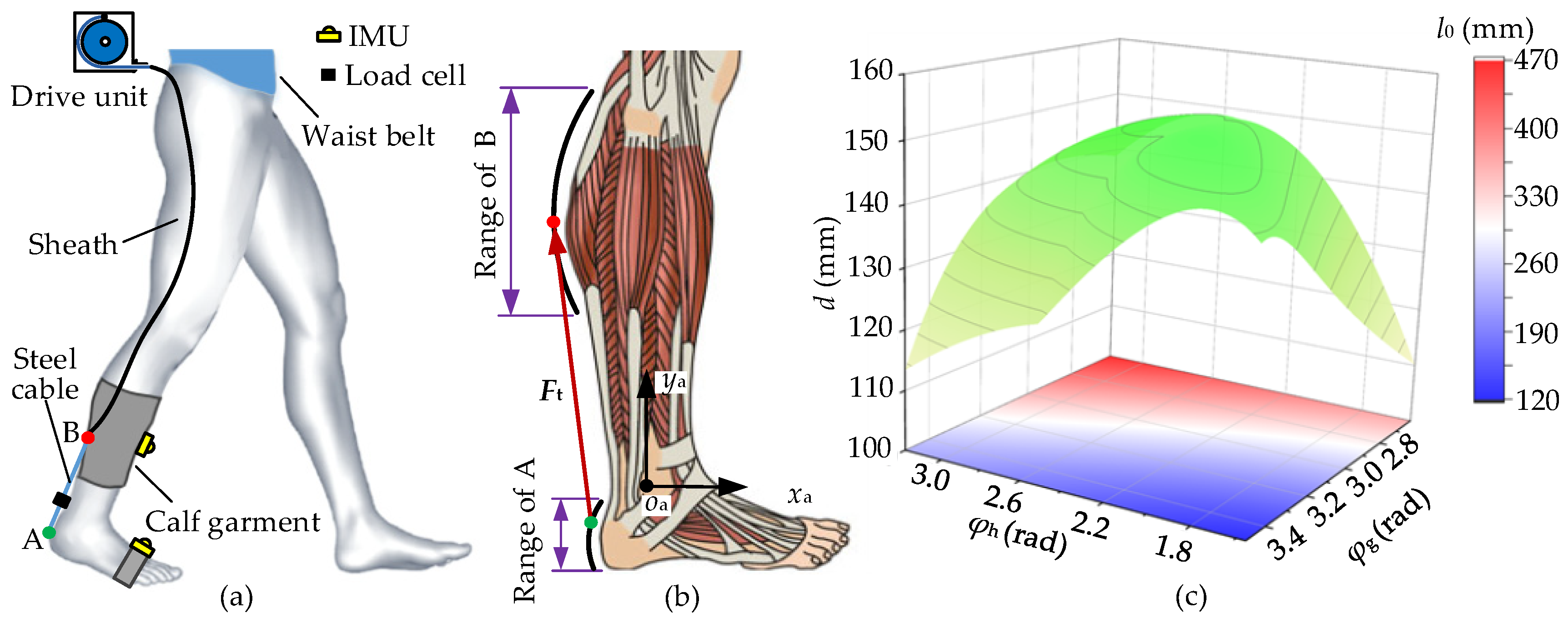
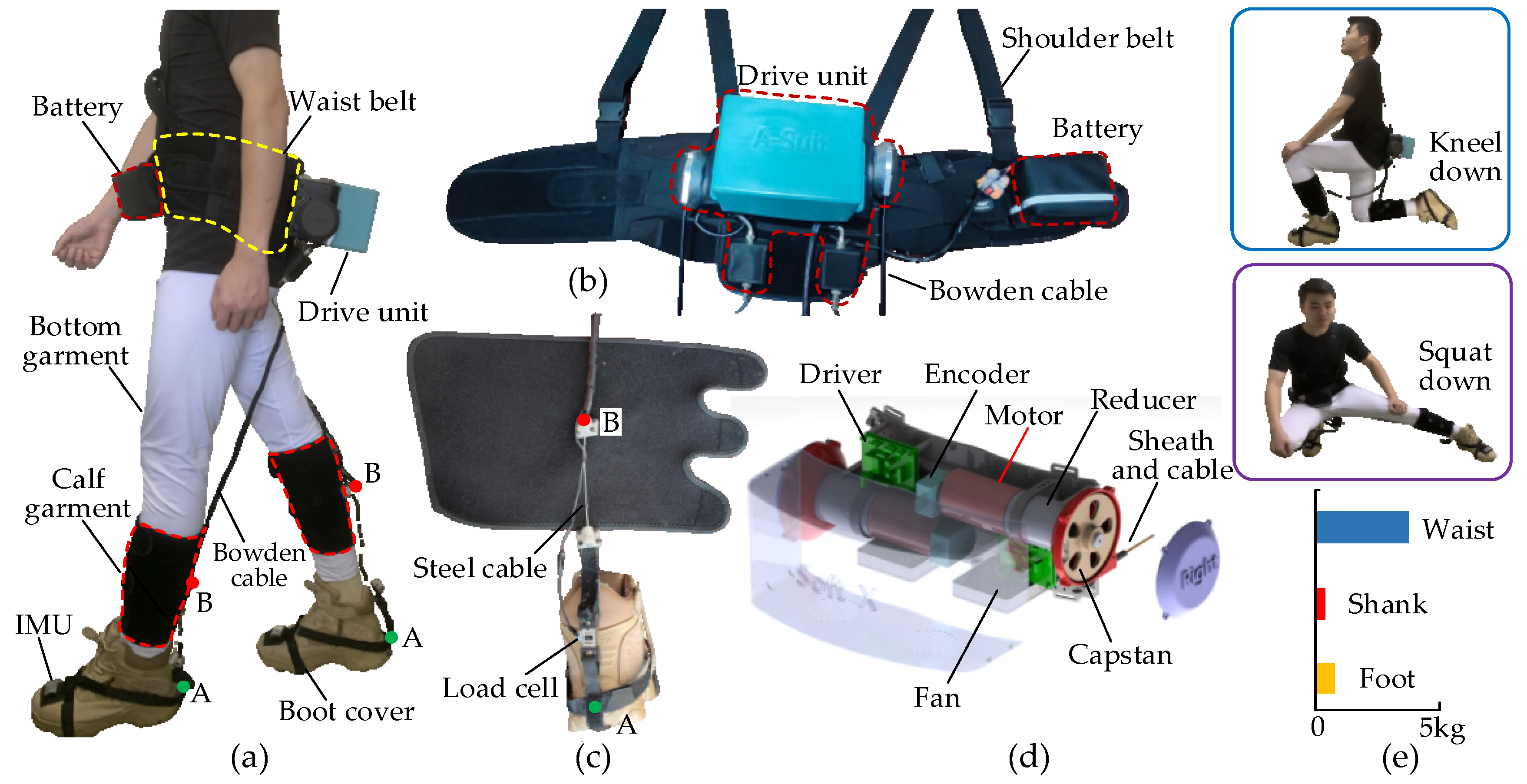
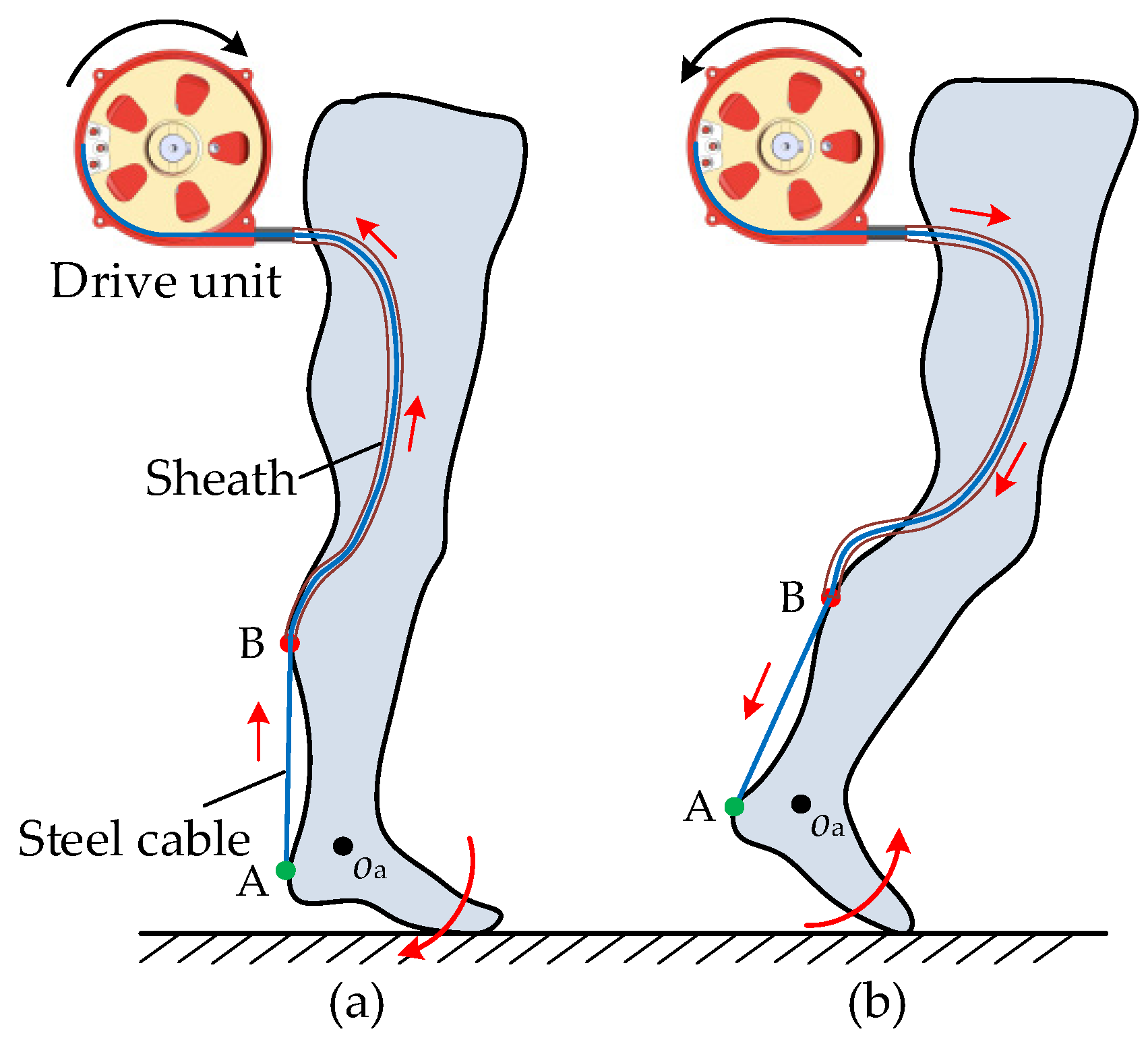
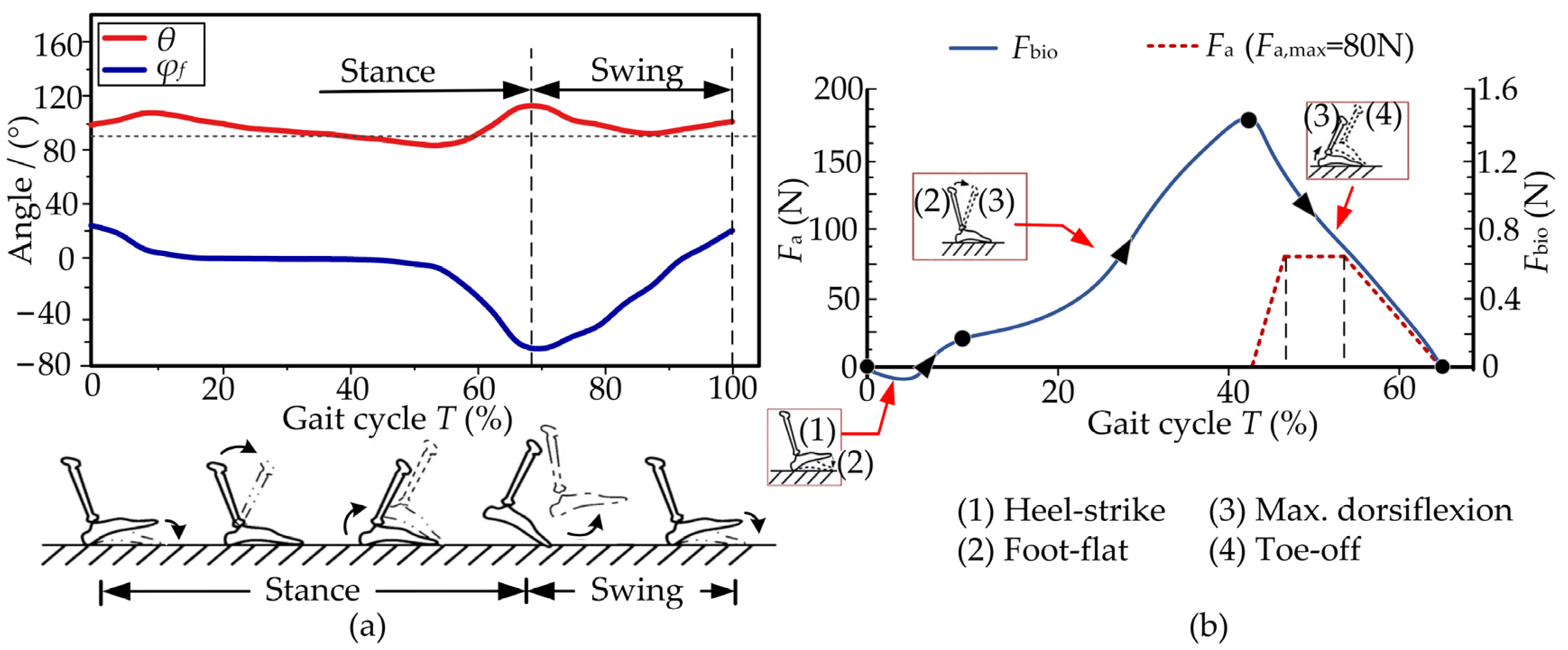
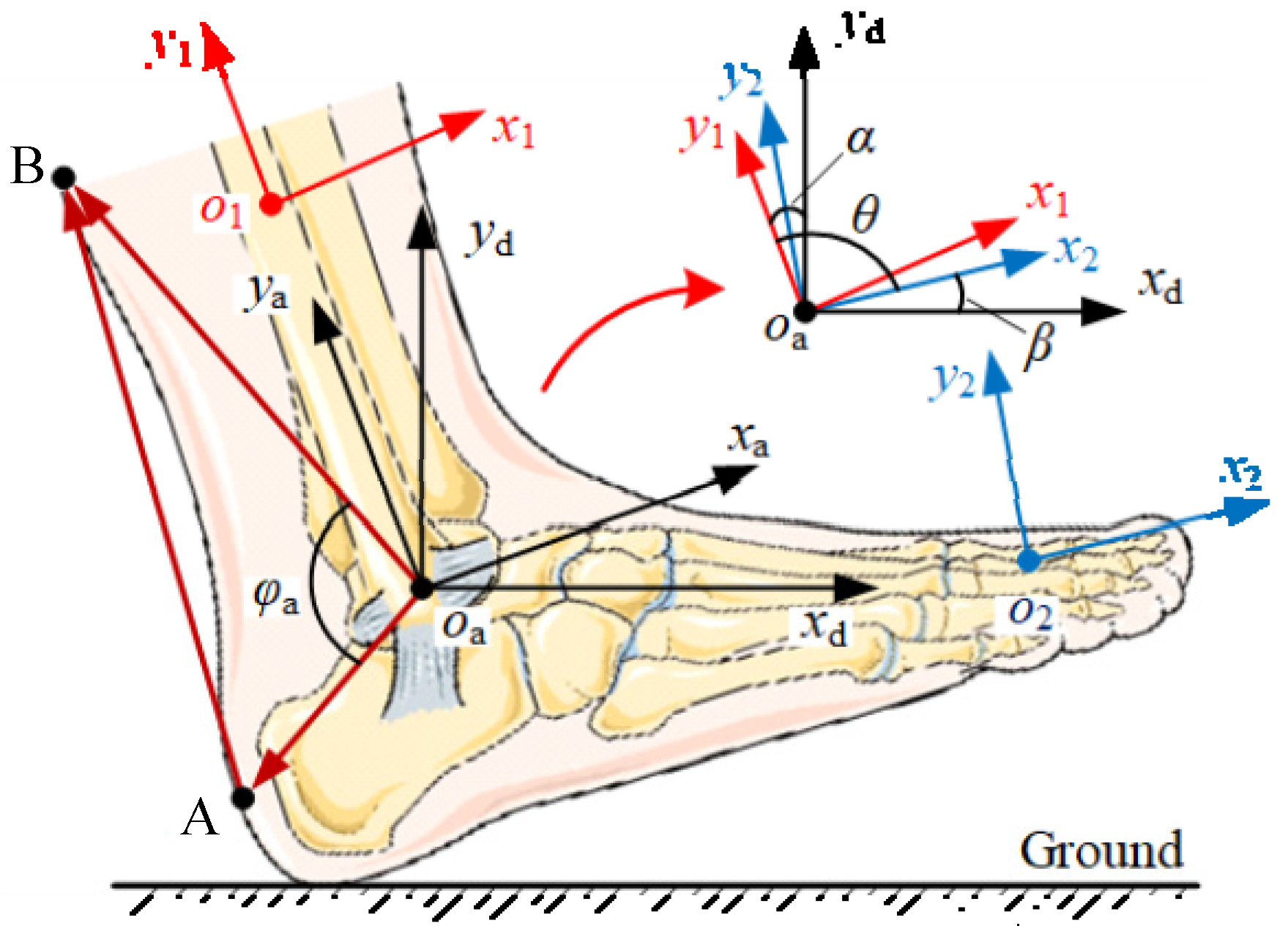
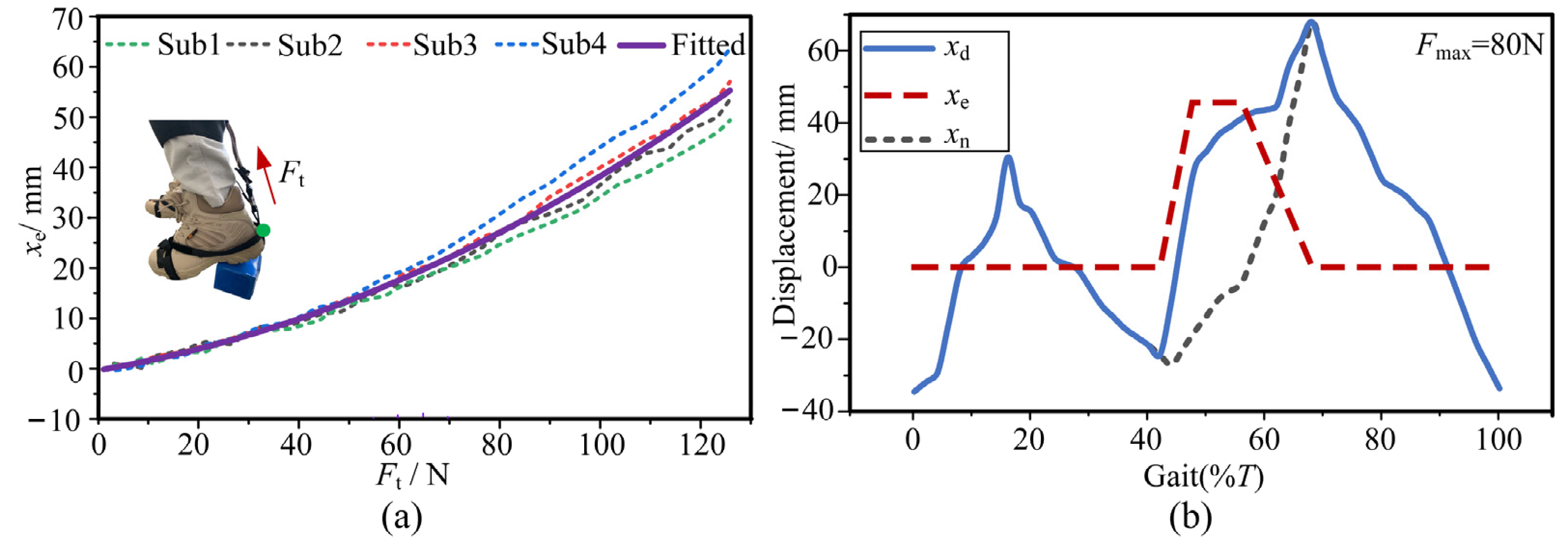

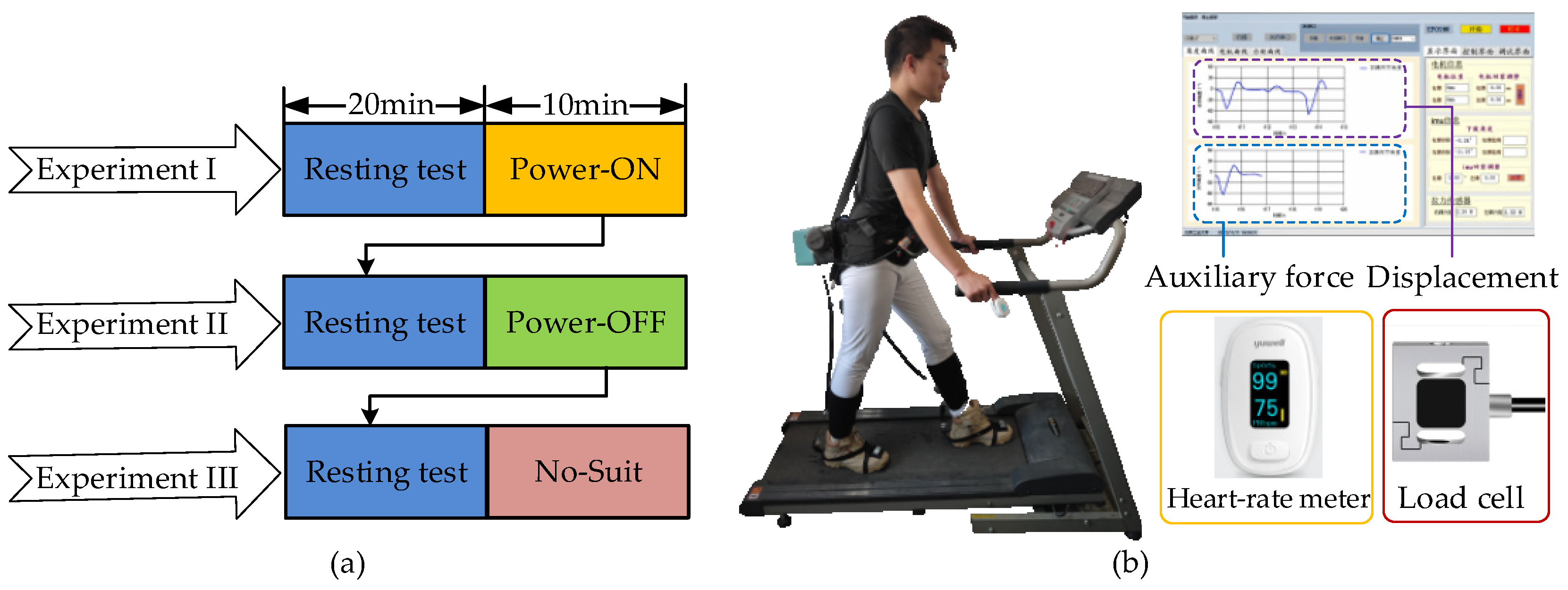

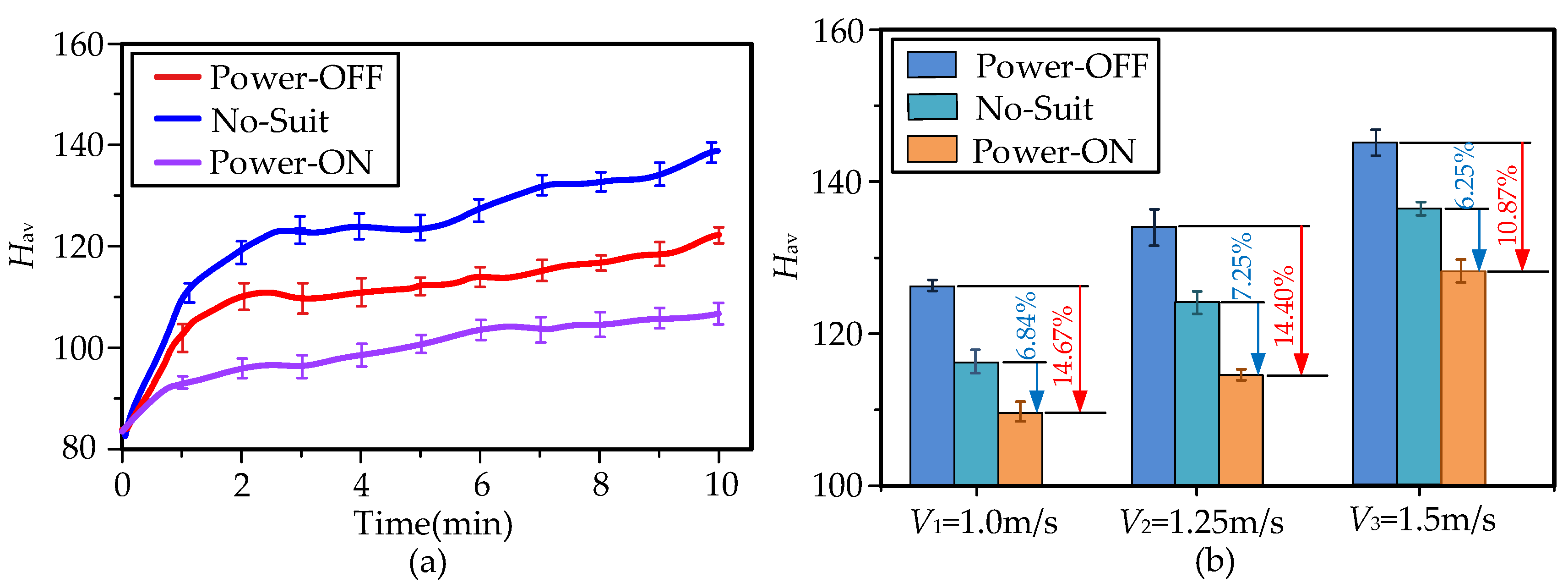

| Params | Values | Params | Values |
|---|---|---|---|
| A0 | −394.05 | A1 | −56.07 |
| A2 | 3514.71 | A3 | −6837.22 |
| A4 | 3797.91 | A5 | 0.44 |
| Params | Values | Params | Values |
|---|---|---|---|
| V1 | 1.0 m/s | V2 | 1.25 m/s |
| V3 | 1.50 m/s | L | 2.26 |
Publisher’s Note: MDPI stays neutral with regard to jurisdictional claims in published maps and institutional affiliations. |
© 2022 by the authors. Licensee MDPI, Basel, Switzerland. This article is an open access article distributed under the terms and conditions of the Creative Commons Attribution (CC BY) license (https://creativecommons.org/licenses/by/4.0/).
Share and Cite
Zhang, L.; Gao, X.; Cui, Y.; Li, J.; Ge, R.; Jiao, Z.; Zhang, F. Ergonomics Design and Assistance Strategy of A-Suit. Micromachines 2022, 13, 1114. https://doi.org/10.3390/mi13071114
Zhang L, Gao X, Cui Y, Li J, Ge R, Jiao Z, Zhang F. Ergonomics Design and Assistance Strategy of A-Suit. Micromachines. 2022; 13(7):1114. https://doi.org/10.3390/mi13071114
Chicago/Turabian StyleZhang, Leiyu, Xiang Gao, Ying Cui, Jianfeng Li, Ruidong Ge, Zhenxing Jiao, and Feiran Zhang. 2022. "Ergonomics Design and Assistance Strategy of A-Suit" Micromachines 13, no. 7: 1114. https://doi.org/10.3390/mi13071114
APA StyleZhang, L., Gao, X., Cui, Y., Li, J., Ge, R., Jiao, Z., & Zhang, F. (2022). Ergonomics Design and Assistance Strategy of A-Suit. Micromachines, 13(7), 1114. https://doi.org/10.3390/mi13071114







